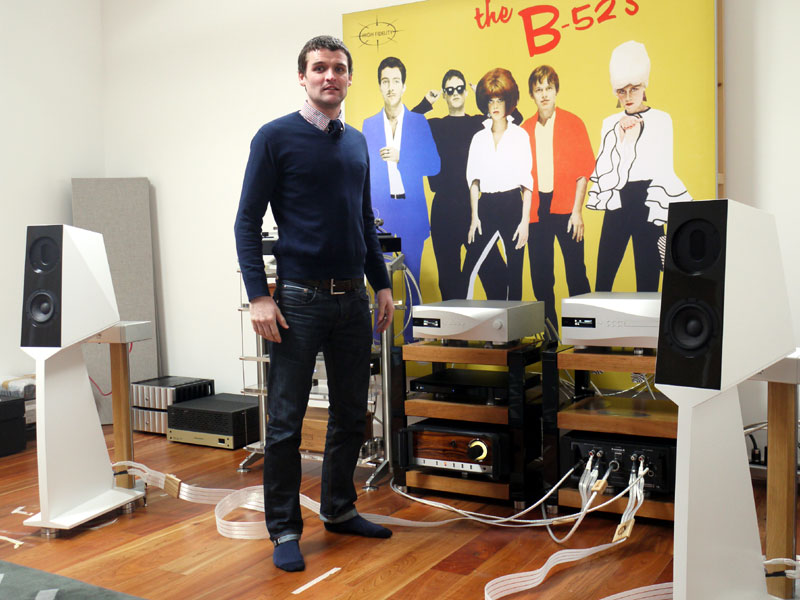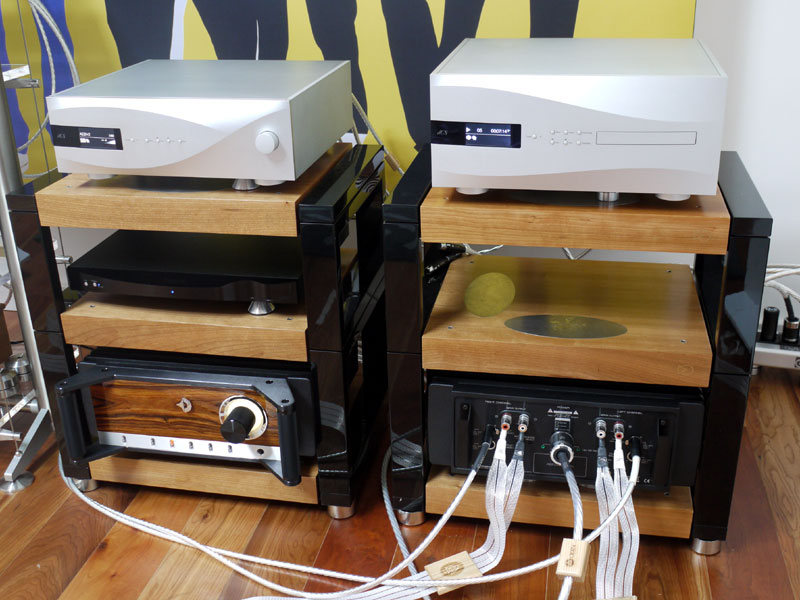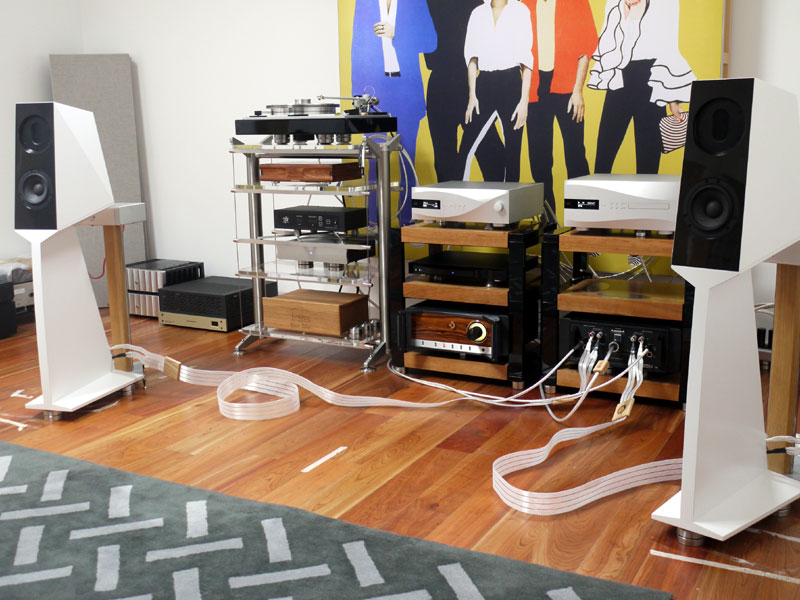Four Seasons in One Day: An All-Too-Brief Encounter with Half the dCS Vivaldi Stack
’m on record (several times now) reporting impressive results from the new, impressively large and imposingly pricey dCS Vivaldi four-box digital-replay system at a range of different shows and events. So, offered a quick peek and listen at home, I certainly wasn’t going to turn down the opportunity, especially as, with the system in a state of flux, for once incorporating equipment on a flying visit wasn’t going to present the normal headaches. For a number of practical reasons -- mainly to do with cable lengths and associated equipment required for specific systems and reviews -- I’ve been living with the equipment placed between the speakers, neither my normal nor my favorite placement. However, the temporary nature of the arrangement does offer a couple of benefits, not least an unfamiliar willingness to ring the changes. So when David Steven from dCS (below) suggested dropping by for a bike ride (Oh, and he might just pop a Vivaldi in the car) it was the cue to clear the decks and reconfigure for incoming.
David drove down in the evening, allowing us to get the Vivaldi plumbed in and warmed up overnight. With the next morning given over to two-wheeled activity, the units should have a better-than-normal chance of delivering something representative, despite their fleeting visit. First surprise -- only two boxes. Isn’t the Vivaldi four-boxes, big and suitably expensive? Well, yes and no, which, as I was to discover, was the whole point of David’s visit. Whilst it’s easy to take one look at the carefully sculpted chassis of the Vivaldi components and consider them a single monolithic entity with a similarly monolithic price tag -- after all, who bothers to list the components separately? -- in fact it is more sensible to treat the Vivaldi boxes as a family of digital replay options. David arrived with the transport and DAC -- a good old-fashioned two-box replay system. Like many CD players and DACs these days, the Vivaldi DAC will accept USB 2.0 Class 2 input, as well as AES/EBU (singly or as pairs) and S/PDIF on BNC or TosLink, thus offering as much digital-decoding versatility as many of us need -- at a considerable savings over the full four-box stack. Likewise, a dedicated computer-audio user might opt for just the DAC with or without the separate streamer/upsampler. In either case, once you have two dCS boxes up and running you have the option of adding the clock to create a three-box solution. Throw in the fact that various existing dCS components are also cross-compatible and the cost of Vivaldi ownership starts to look a whole lot more reasonable -- which is probably just as well, as even a brief encounter has left me seriously smitten. (Hmmm, there’s probably a film script somewhere in that sentence.)
Note the Puccini uClock lurking below the DAC and the various spare interconnects awaiting reconfiguration.
Take a look at the accompanying pictures and you’ll see a slightly unusual system setup. The first thing that will probably strike you is the mess of cables. Look a little closer and you’ll notice that the AvantGarde XA Power amp is actually backwards in the rack, its rear end and what remains of its modesty open to public show. In and of itself, that placement isn’t that unusual. I often mount power amps backwards, making cable or equipment swaps (up or downstream) far easier, quicker and above all, safer. What is unusual is that the cables aren’t dressed a lot more carefully, but then there’s a reason for that too. One of the key tenets in the dCS approach is the ability to drive the power amp directly from the DAC, a facility that is especially attractive in a digital-only setup. It’s a subject on which, over the years, the company and I have had to agree to differ -- although, in fairness to dCS, I’ve had the same debate with Wadia and others. But recent more positive experiences with the Jeff Rowland Aeris DAC used in this mode -- as well as my previous experience with the Vivaldi -- left me interested in looking at this option once again; hence the multiple sets of cables and the power amp’s backside bared to view, all arranged to allow easy comparison between the Vivaldi DAC driving the amp direct or via the XA Pre. It’s not a level of system housekeeping I’d tolerate on a long-term basis, but sometimes needs must. The first thing that strikes you about the Vivaldi components (apart from their significant weight) is their superior appearance. The bead-blasted aluminum fascia used on the new units is both elegant and tough, while the operational interface is a vast improvement on my Paganini's, helped in no small part by the best-looking and most legible displays I’ve ever encountered on a hi-fi component. No question, when it comes to the user experience, these latest dCS products certainly toe the line.
Despite a comparatively short listening window, two things were abundantly clear: The two-box Vivaldi disc player sounded very, very good indeed -- so good that it represented a step-change in performance for dCS. Music had a supple, articulate, fluid quality quite at odds with the solid bulk of the equipment producing it, although that visual discontinuity was alleviated by the fact that the music also sounded remarkably coherent and independent of the system as a whole. It also had a sense of presence and physical substance that I’ve not heard from a dCS player before. Not a heavy, thickened or turgid sound, but a rightness to the shape, scale and body of instruments, a more positive and emphatic sense of musical emphasis and the weight of a player’s hand on string or key. Even using the small Kaiser Chiara speakers (review forthcoming), there was no sense that we were losing bass or substance. Rhythmic shifts were traversed without fuss or stumbles and the overall result was both informative and musically engaging, taking all the traditional dCS strengths of resolution, transparency and stability, but combining them with a new sense of energy and almost physical impetus. All of which makes the Vivaldi a very interesting prospect indeed -- albeit a not inexpensive one. The transport weighs in at £24,499 and the DAC will add another £19,999 ($39,999 and $34,999 respectively in the US), making this one expensive replay solution, even in its two-box form. Even so, it’s tempting to look at the steps dCS have taken, over and above the established Scarlatti, with a speculative view to attributing the credit for what is a significant advance in performance. I’m sure that the new dual-mono Ring DAC implementation plays its part, but I’d love to be able to separate out the influence of three other aspects of the design: the enormous care that’s gone into the electrical and physical isolation of the transport, the adoption of a dual-AES/EBU data connection in place of the previous FireWire, and the design of an all-new discrete analog output stage. I guess I’ll never know, but it is going to be fascinating to determine how the Vivaldi experience shapes the rest of the range. One thing, however, needs no speculation at all. As longtime advocates of external clocks, dCS naturally provide one as part of the Vivaldi family. I couldn’t help but wonder just how it might influence the sound of the two-box disc player. Without even missing a beat, David’s response was, "Well, why don’t we hook up your Paganini’s uClock?" A few more cables later (I mean, what’s a Nordost Odin or two between friends?) and we were, quite literally ready to rock. As impressive as the Vivaldi units were on their own, the uClock brought a sense of power and dynamic heft, a sureness and fleetness of foot, an articulation of microdynamic detail that didn’t just bring the music to life, it all allowed it to step away from the system completely, occupying an entirely independent space behind the plane of the speakers, with an acoustic space that stretched way beyond them. Bass was even more convincing and, in a speaker where enthusiasm can easily lead to overdriving, it was also better controlled, allowing us to play the system louder without the Chiara's diminutive bass/mid drivers going into apoplexy. Playing SACD recordings, both standard and SHM discs, was especially satisfying, with none of the leanness or pared-away, ethereal quality that sometimes undermines the medium. Given my affection for the format and the number of SACDs in my collection, that’s a huge benefit as far as I’m concerned. I guess there are two ways of looking at this: On the one hand, having spent nearly £45,000 on a two-box player, should you really need to add a clock? On the other, look on the bright side -- at a little over £3000, it’s one seriously cost-effective upgrade and it will definitely keep you going, whether or not you choose to step up to the (far more sophisticated and expensive) Vivaldi clock at a later date. Now all the uClock needs is a matching bead-blasted front-panel option! As suggested earlier, we tried the system running via the XA Pre and directly from the DAC’s variable output. Whilst I’m still not a convert to the latter topology, the Vivaldi’s implementation has come a long, long way. I may prefer the sheer presence and drive that come from using a good preamp (and the XA Pre is extremely good), but we’ve reached a point where direct connection of the DAC to the XA Power was delivering certain clear benefits, particularly in terms of spatial separation and transparency, to the extent that I could certainly see some listeners preferring the option. Alas for David, my retrogressive love of analog sources
and records pressed before I was born means he’ll probably never manage to convince
me -- at least not as a permanent solution. But the wistful looks that followed the
Vivaldi units as they were reboxed constitute a significant victory for dCS, at least as
far as this listener is concerned. Next step is to get them back for a full review, after
which who knows? Mr. Steven's rash comments regarding his willingness to take back my
Paganini pieces could well come back to haunt him! |





